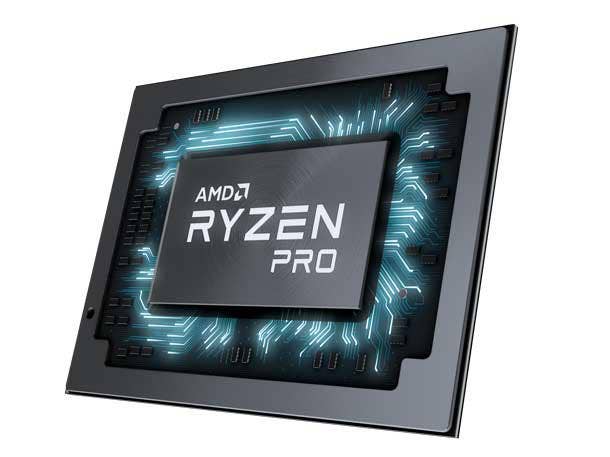New AMD Ryzen Pro 3000 CPUs To Take On Intel vPro
The chipmaker's new Ryzen Pro 3000 processors sport up to 12 cores for multitasking and multithreaded applications and built-in security and manageability features for commercial PCs.

AMD is bringing its third-generation Ryzen processors to the commercial PC segment with the new Ryzen Pro 3000 series, providing businesses with built-in security and manageability features while also giving them up to 12 cores of processor power that can benefit multitasking.
The Santa Clara, Calif.-based company announced the global availability of its Ryzen Pro 3000 desktop processors Monday in addition to new Ryzen Pro and Athlon Pro processors that come with integrated Radeon Vega graphics, creating more competition for Intel's vPro processors. New enterprise desktop PCs coming from HP Inc. and Lenovo will come with the processors.
[Related: AMD's Ryzen 3000 Fight Against Intel Opens Big Channel Opportunities]
Solution providers who work with Intel and AMD have previously told CRN that AMD's new Ryzen processors give the company a new edge against Intel and create opportunities for the channel in the client PC market.
"Intel no longer just dominates in every aspect," Wallace Santos, CEO of Maingear, a Kenilworth, N.J.-based system builder that sells Intel- and AMD-based PCs for the enthusiast market, told CRN in July.
Saied Moshkelani, senior vice president and general management of AMD's Client Compute business, called the launch of the company's Ryzen Pro 3000 series for commercial and small-business customers "the latest demonstration of our commitment to technology leadership in 2019."
"Designed specifically to efficiently data-crunch, design, compose,and create—AMD Ryzen Pro and Athlon Pro processors accelerate enhanced business productivity while offering protection safeguards with built-in security features, such as full system memory encryption and a dedicated, on-die security processor," he said in a statement.
The new processors are based on AMD's 7-nanometer Zen 2 architecture, which also serves as the basis for the chipmaker's second-generation EPYC server processors and third-generation Ryzen consumer desktop processors that launched in the past few months.
The new Ryzen Pro 3000 series is headlined by the Ryzen 9 Pro 3900, which comes with 12 cores, 24 threads, a base clock frequency of 3.1GHz and a max boost clock of up to 4.3GHz in a 65-watt envelope. Meanwhile, the Ryzen 7 Pro 3700 features eight cores and 16 threads but higher base and boost clock frequencies of 3.6GHz and 4.4GHz, respectively. The Ryzen 5 Pro comes with six cores, 12 threads, a base clock of 3.6GHz and max boost clock of up to 4.2GHz.
AMD said the Ryzen 9 Pro 3900 and Ryzen 7 Pro 3700 provide a two-fold performance increase over comparative processors from Intel using the same power. At the same time, the company said its processors provide an estimated 127 percent faster data-crunching capability versus Intel's vPro processors for verticals ranging from financial services to life sciences.
For AMD's new Ryzen Pro processors that come with integrated Radeon Vega graphics, the lineup is headlined by the Ryzen 5 Pro 3400G, which comes with four cores, eight threads, a base frequency of up to 3.7GHz, a boost clock of 4.2GHZ and 11 graphics execution units. The other processors, the Ryzen 5 Pro 3400GE, Ryzen 3 Pro 3200G and Ryzen 3 Pro 3200GE, go down to four cores, a base frequency of up to 3.3GHz and a boost clock of 3.8GHz.
The new AMD Athlon Pro 300GE comes with two cores, four threads, a base clock frequency of up to 3.4GHZ, a turbo frequency of 3.4GHz and three graphics compute units in a 35-watt envelope.
HP is supporting AMD's new launch with the HP EliteDesk 705 G5 small form factor, which comes with dual-drive M.2 drive capabilities, and the HP EliteDesk 705 G5 Desktop Mini, a PC with an even smaller form factor that pairs with the company's HP Mini-in-One 24 Display.
Lenovo, on the other hand, is supporting the release of the new Ryzen processors with its own small-business PC builds, the ThinkCentre M75s-1 small form factor and M75q-1 tiny form factor systems, the former of which will support AMD's new 12-core Ryzen 9 Pro 3900.
All Ryzen Pro CPUs come with a built-in security co-processor that runs AMD GuardMI technology, which is designed to protect against cold boost attacks with full system memory encryption—a capability that complements OEM security features, like Lenovo ThinkShield and HP Sure Start.
"Our customers want smart and secure desktops to meet the day-to-day rigors of workplace demands with the flexibility to adapt to modern workspaces," Tom Butler, executive director of worldwide commercial portfolio and product management at Lenovo, said in a statement. "We equip select ThinkCentre models with state-of-the-art AMD processors that deliver great performance and security features in one device."
Ryzen's high core counts have been a major talking point for AMD in positioning itself against Intel, whose equivalent desktop processor lineup, the ninth-generation Core series, features only up to eight cores. However, Intel has continued to pride itself on sporting faster clock frequencies, with its flagship Core i9-9900K featuring a maximum turbo frequency of 5GHz.
Recently, Intel questioned the reliability of AMD's Ryzen 3000 processors, pointing to customer complaints that some processors weren't reaching their advertised boost frequencies. AMD has said that an upcoming BIOS update for motherboards will fix the issue and provide other optimization.
Randy Copeland, CEO of Velocity Micro, a Richmond, Va.-based system builder that sells Intel- and AMD-based PCs and workstations for the enthusiast and commercial markets, told CRN earlier this month that he saw the issue as temporary and doesn't think it diminishes the processors' capabilities for multitasking and multithreaded applications.
"Having the fastest frequency or having your boost clock frequency hit at the advertised speeds on all cores isn't going to be important in a real-world scenario," he said at the time. "No high-end gamer could ever tell the difference unless you run tests. It's almost exclusively for bragging rights."